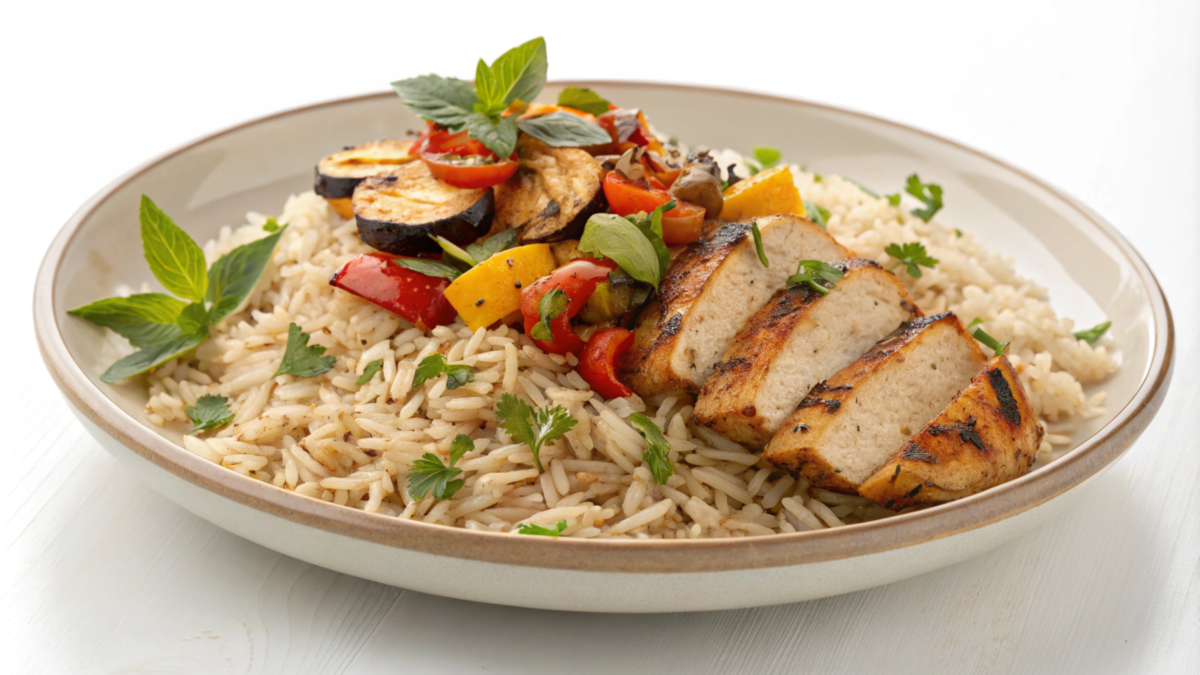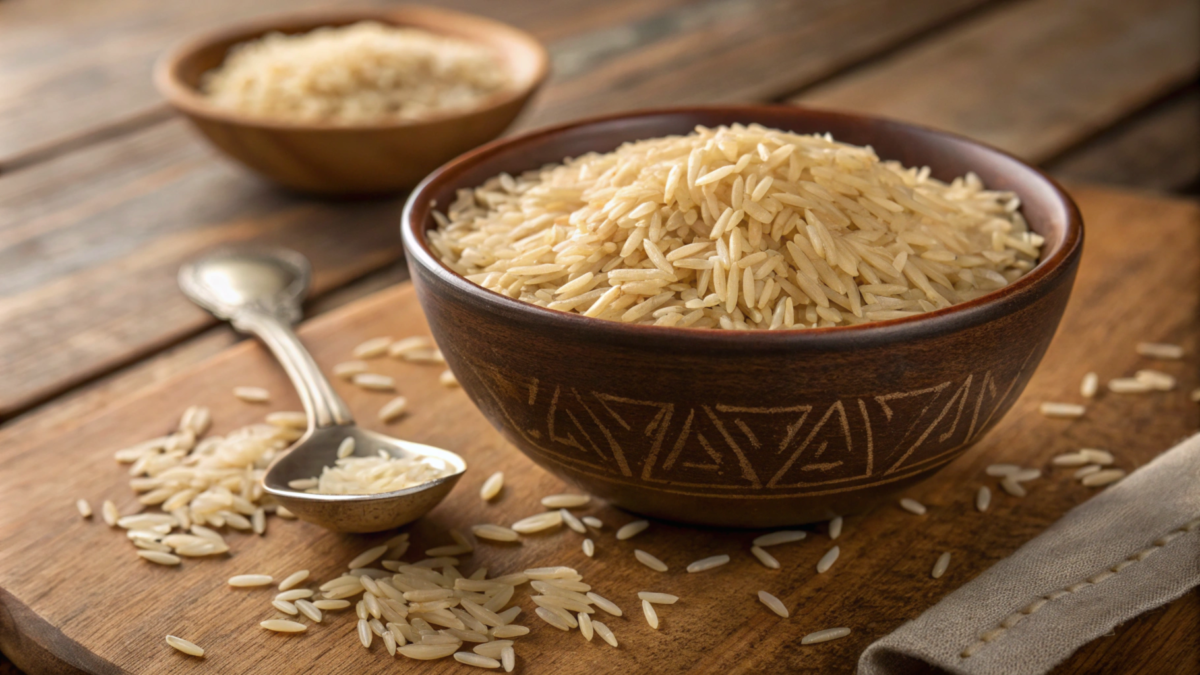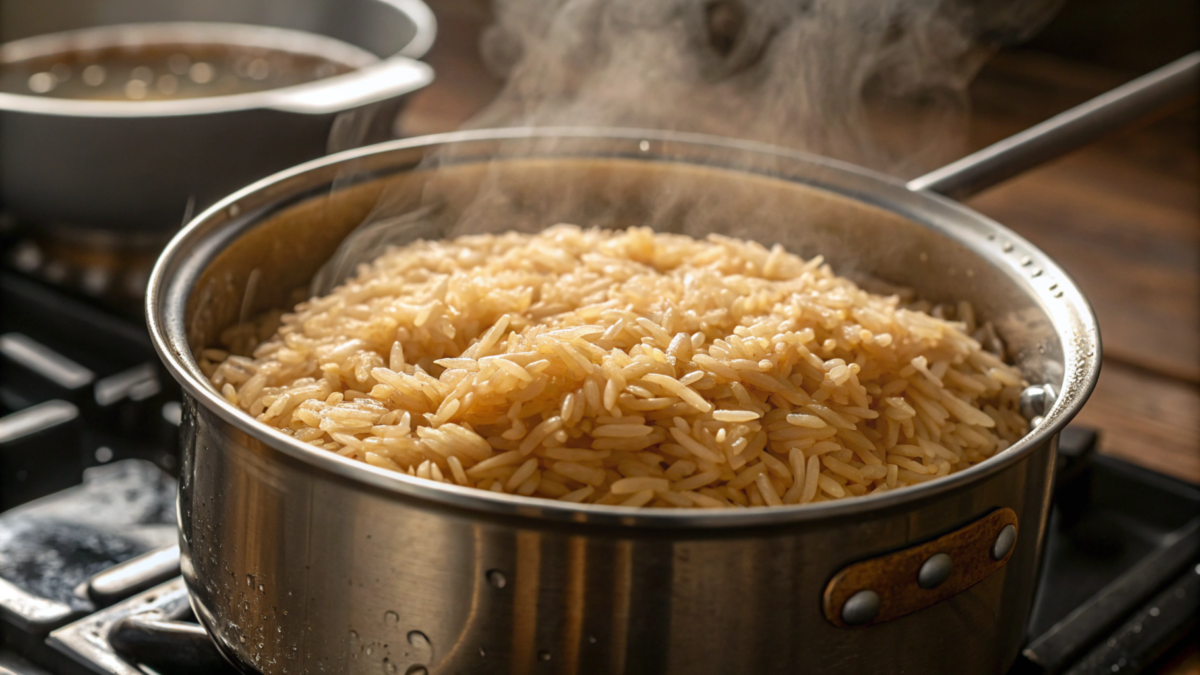Part 1: Understanding Brown Basmati Rice
What is Brown Basmati Rice?
Brown basmati rice is a natural, less-processed form of traditional basmati rice. It keeps its outer bran layer intact, which protects its nutrients. This layer gives the rice a chewy texture and a nutty taste. The long grains and rich aroma make it stand out from other types of brown rice. Unlike white basmati rice, which is polished to remove the bran and germ, brown basmati rice is minimally processed, making it a more wholesome choice.
Origin and History
Basmati rice has a history stretching back thousands of years to India and Pakistan. The word “basmati” comes from the Sanskrit word vasmati, meaning “fragrant,” perfectly describing its natural aroma. In the past, this rice was seen as a symbol of wealth and served during celebrations and royal banquets. Today, it is enjoyed worldwide, loved for its unique flavor and connection to cultural traditions.
Unique Characteristics
What makes brown basmati rice special is how it combines nutrition with great taste. Its key features include:
- Aromatic Appeal: A gentle, nutty fragrance that enhances any meal.
- Long, Slender Grains: The grains elongate beautifully when cooked, adding a touch of elegance.
- Chewy Texture: The bran layer provides a firm, satisfying bite.
- Nutritional Value: As a whole grain, it is rich in fiber, magnesium, and selenium.
Link Out: Curious about why whole grains matter? Check out this Healthline article on whole grains.
Part 2: Nutritional Profile and Health Benefits
Nutritional Value of Brown Basmati Rice
Brown basmati rice is not just tasty—it’s packed with nutrients that support your health. By keeping its outer layers, this rice retains fiber, healthy oils, and vitamins. Let’s explore its nutritional highlights.
Macronutrients
- Carbohydrates: Provides long-lasting energy, making it ideal for active people.
- Protein: Supplies 3–4 grams per serving, a good base for pairing with beans or lean meat.
- Healthy Fats: Contains natural fats in small amounts, adding energy without extra calories.
This balance of macronutrients makes brown basmati rice a great addition to a healthy diet.
Vitamins and Minerals
- Magnesium: Supports muscle health, strong bones, and hundreds of body functions.
- Selenium: Protects cells from damage and supports thyroid health.
- B Vitamins: Boost energy and help maintain the nervous system.
- Iron: Promotes healthy blood and oxygen flow.
Adding brown basmati rice to your meals is an easy way to increase your intake of these essential nutrients.
Health Benefits
The benefits of brown basmati rice go beyond taste and nutrition. It offers numerous health advantages for those who include it in their diet.
Digestive Health
Rich in dietary fiber, brown basmati rice helps improve digestion by adding bulk to stool, making bowel movements easier. Fiber also nourishes healthy gut bacteria, supporting a balanced gut microbiome. Its chewy texture encourages slow eating, aiding better digestion and reducing overeating.
Glycemic Index and Blood Sugar Control
Brown basmati rice has a low glycemic index, meaning it releases sugar into the blood slowly. This makes it a fantastic choice for people managing diabetes or anyone looking for steady energy throughout the day. Plus, its magnesium content helps improve insulin sensitivity, further enhancing blood sugar regulation.
Link Out: Learn more about how the glycemic index impacts your diet at this comprehensive guide.
Part 3: Culinary Uses and Preparation Methods
Cooking Brown Basmati
Cooking brown basmati rice may take a little extra time compared to white rice, but the effort is absolutely worth it. Its nutty flavor and chewy texture shine when cooked just right. Each method of preparation caters to different kitchen setups and preferences, ensuring there’s something for everyone. Whether you prefer the traditional stovetop or a modern instant pot, brown basmati rice is incredibly versatile.
Stovetop Method
The stovetop method is a timeless way to cook brown basmati rice, perfect for preserving its nutty flavor and fluffy texture:
- Rinse: Start by rinsing the rice under cold water to remove excess starch. This step prevents stickiness.
- Measure: Use a ratio of 1 cup rice to 2.5 cups water. Add a pinch of salt for taste.
- Boil and Simmer: Bring the water to a boil, then lower the heat and let the rice simmer, covered, for 40–45 minutes. Avoid lifting the lid frequently.
- Rest and Fluff: After cooking, let the rice rest for 5 minutes, then fluff with a fork for perfectly separated grains.
Rice Cooker Method
For those who love convenience, the rice cooker is a reliable option:
- Rinse: As always, rinse the rice thoroughly.
- Add Water: Use the same 1:2.5 rice-to-water ratio. If your rice cooker has a brown rice setting, even better!
- Set and Forget: Start the cooker and let it handle the rest. It’ll automatically switch to “keep warm” once done.
Using a rice cooker ensures consistent results, ideal for meal preppers and busy cooks.
Instant Pot Method
The Instant Pot is a game-changer for cutting down cooking time without sacrificing quality:
- Rinse and Soak: Rinse the rice and, optionally, soak it for 20–30 minutes to reduce cooking time further.
- Pressure Cook: Combine 1 cup rice with 2 cups water in the Instant Pot. Seal the lid and set it to “Pressure Cook” on high for 20 minutes.
- Natural Release: Allow the pressure to release naturally for 10 minutes before opening the lid. Fluff the rice gently and serve.
Culinary Applications
Brown basmati rice isn’t just a side dish; it’s the star of numerous traditional and modern recipes, elevating meals with its nutty aroma and firm texture.
Traditional Dishes
In South Asian cuisine, brown basmati rice forms the foundation of iconic dishes:
- Brown Basmati Pilaf: A fragrant blend of rice, spices, and sautéed vegetables.
- Kitchari: A comforting Ayurvedic dish of rice and lentils, ideal for detoxifying the body.
- Stuffed Bell Peppers: Peppers filled with spiced brown basmati rice and baked to perfection.
These recipes showcase how brown basmati rice carries the essence of traditional flavors.
Modern Recipes
As food trends evolve, brown basmati rice has found its way into contemporary culinary creations:
- Rice Bowls: Combine it with roasted veggies, avocado, and a drizzle of tahini for a wholesome meal.
- Grain Salads: Toss it with kale, cranberries, and almonds for a refreshing salad.
- Brown Rice Sushi: Swap white rice for brown basmati to add an earthy twist to sushi rolls.
The versatility of brown basmati rice ensures it fits effortlessly into both classic and innovative dishes.
Link Out: Looking for more recipe inspiration? Check out traditional basmati rice recipes for ideas!
Part 4: Storage, Selection, and Purchasing
Selecting Quality Brown Basmati Rice
Choosing the right brown basmati rice is key to enjoying its full flavor and nutritional benefits. Not all rice is created equal, and understanding what to look for can help you avoid subpar options. Whether shopping online or in-store, paying attention to quality indicators ensures the best results.
Indicators of Freshness
Freshness matters when it comes to brown basmati rice. Here’s what to look for:
- Color: Opt for grains that are light to medium brown. Avoid rice that appears overly dark or discolored, as this could indicate aging or improper storage.
- Aroma: Fresh brown basmati has a distinct nutty fragrance. A lack of aroma might signal that the rice is stale.
- Packaging: Choose rice packaged in airtight, sturdy containers. Look for vacuum-sealed or resealable bags to ensure freshness.
Trusting your senses—sight and smell—can be incredibly helpful when selecting high-quality rice.
Organic vs. Conventional
When deciding between organic and conventional brown basmati rice, consider the following:
- Organic Options: Organic brown basmati rice is grown without synthetic pesticides or fertilizers, making it a great choice for those prioritizing health and sustainability. It’s often non-GMO and certified by regulatory bodies.
- Conventional Options: While often more affordable, conventional rice may contain pesticide residues. However, reputable brands test and clean their products rigorously to meet safety standards.
Ultimately, your choice depends on your budget and preference for organic farming practices.
Storage Guidelines
Proper storage of brown basmati rice is essential to maintain its flavor, aroma, and nutritional value. Its natural oils can make it prone to spoilage if not stored correctly.
Shelf Life
The shelf life of brown basmati rice is shorter than white rice due to its bran layer. Here’s a general guideline:
- Unopened Package: Typically lasts 6–12 months when stored in a cool, dry place.
- Opened Package: Best used within 6 months to prevent the oils from turning rancid.
Always check expiration dates on packaging and aim to use the rice before it approaches the listed date.
Proper Storage Conditions
To extend the life of your brown basmati rice:
- Cool and Dry: Store rice in an area away from heat, moisture, and direct sunlight. A pantry or cupboard works well.
- Airtight Containers: Transfer rice to airtight containers or mason jars after opening the package. This prevents exposure to humidity and pests.
- Refrigeration or Freezing: For long-term storage, consider refrigerating or freezing brown basmati rice. This can significantly slow oxidation and spoilage.
Adhering to these storage practices ensures that your rice remains fresh and ready to use whenever needed.
Part 5: FAQs About Brown Basmati Rice
What distinguishes brown basmati rice from white basmati rice?
The primary difference lies in processing. Brown basmati rice retains its outer bran layer, which is packed with fiber, vitamins, and minerals. This makes it nuttier in taste, chewier in texture, and healthier overall. In contrast, white basmati rice has the bran and germ removed, resulting in a lighter, fluffier texture but a lower nutritional profile. Brown basmati is the go-to for those seeking a more nutritious option without compromising on the aromatic charm of basmati.
Is soaking brown basmati ricee necessary before cooking?
While not strictly required, soaking brown basmati rice is highly recommended. Why? It helps soften the grains, shortens cooking time, and ensures even cooking. For best results, rinse the rice thoroughly to remove excess starch, then soak it in cold water for 20–30 minutes before cooking. This step enhances both the texture and flavor, making the rice more enjoyable to eat.
How does brown basmati rice compare to other brown rice varieties?
When stacked against other brown rice types, brown basmati rice stands out for its long, slender grains and aromatic quality. Regular brown rice has a denser, chewier texture, while brown basmati is fluffier and less sticky. Additionally, the distinct nutty and floral aroma of brown basmati makes it more versatile for global cuisines, from Indian pilafs to Mediterranean salads.
Can brown basmati rice be used in desserts?
Yes, brown basmati rice can be a delightful base for desserts. Its slightly nutty flavor adds depth to recipes like rice pudding, kheer (an Indian sweet dish), and even baked rice casseroles. To make it dessert-ready, cook the rice in milk or coconut milk with a touch of sugar, cinnamon, and cardamom. Add dried fruits, nuts, or a drizzle of honey for a decadent treat.
What is the glycemic index of brown basmati rice?
Brown basmati rice has a low to medium glycemic index (GI) range of 50–58, which is lower than that of white basmati and most other rice varieties. This means it causes a slower, steadier rise in blood sugar levels, making it an excellent choice for diabetics or anyone aiming to maintain balanced energy levels. Its high fiber content also contributes to its blood sugar-friendly nature.
How should cooked brown basmati rice be stored?
To store cooked brown basmati rice, first allow it to cool completely. Place the cooled rice in an airtight container and refrigerate it promptly to prevent bacterial growth. Stored properly, it will remain fresh for 3–5 days. If reheating, sprinkle a few drops of water over the rice and microwave it to restore its moisture and texture. For longer storage, cooked rice can also be frozen for up to a month.
Conclusion: Why Brown Basmati Rice Deserves a Place in Your Diet
Brown basmati rice is much more than a simple grain—it’s a wholesome, nutritious, and versatile food that fits perfectly into a balanced lifestyle. With its rich history, unique flavor, and impressive health benefits, it’s no wonder this rice variety has become a staple in households worldwide. Whether you’re looking for a high-fiber alternative, a low-glycemic option for managing blood sugar, or an ingredient to elevate your culinary creations, brown basmati rice delivers on all fronts.
By understanding its nutritional value, mastering cooking methods, and incorporating it into both traditional and modern dishes, you can fully enjoy the benefits of this incredible grain. Plus, with proper storage and selection tips, you can ensure every serving is fresh and flavorful.
It’s time to give this aromatic and nutritious grain the spotlight it deserves in your kitchen. Start exploring the world of brown basmati rice today, and let its natural goodness transform your meals into something extraordinary.



